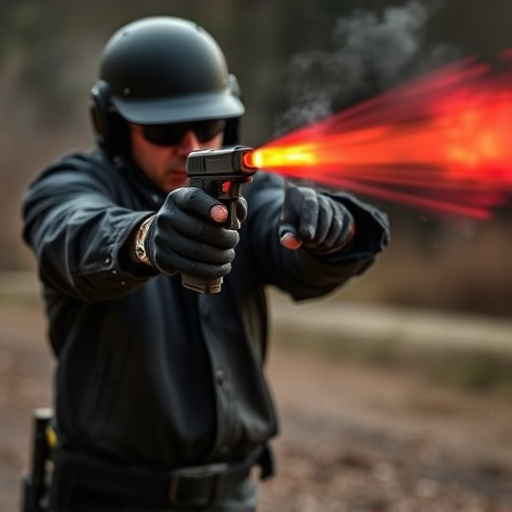Pepper spray, a powerful non-lethal defense tool, uses capsaicin and UV marking dye formula components to temporarily disable attackers by irritating sensitive areas. The UV dye aids in identifying perpetrators and is particularly effective during low-light or nighttime situations, as it leaves an invisible mark that glows under UV light. Proper handling involves maintaining distance, aiming for the eyes, nose, and mouth, and moving to safety after deployment. Regular training ensures readiness. Modern pepper sprays incorporate UV-reactive components for enhanced self-defense in various conditions.
“Uncover the power of pepper spray as a vital self-defense tool with our comprehensive guide. From understanding its basic operation to exploring the enhanced visibility benefits of UV marking dye, this article equips you with crucial knowledge. Discover how to navigate safety considerations and handle pepper spray effectively. Learn about the formula behind its active ingredients, ensuring you’re prepared for any situation. Optimize your self-defense strategy by integrating these insights on UV marking dye pepper formula.”
- Understanding Pepper Spray: The Basics of its Operation and Effectiveness
- UV Marking Dye in Pepper Spray: Enhancing Visibility and Impact
- Safety Considerations: How to Properly Handle and Use Pepper Spray for Self-Defense
- The Formula Behind Effective Pepper Spray: Breaking Down Active Ingredients and Their Roles
Understanding Pepper Spray: The Basics of its Operation and Effectiveness
Pepper spray is a non-lethal self-defense weapon designed to temporarily incapacitate an attacker, providing users with valuable time to escape dangerous situations. At its core, pepper spray works by delivering a precise mixture of capsaicin, the active ingredient found in chili peppers, and other UV marking dye pepper formula components. When sprayed, it irritates the eyes, nose, and respiratory system, causing temporary blindness, coughing, and difficulty breathing. This immediate reaction allows users to create distance from their assailants, enhancing their safety and chance of escape.
The effectiveness of pepper spray lies in its ease of use and swift action. A single burst can disable an attacker for several minutes, giving the victim a crucial window to navigate to safety. Moreover, unlike traditional firearms, pepper spray has no permanent physical impact on the target, making it a preferred option for personal protection. The UV marking dye included in the formula further aids in identification, as it leaves visible markings on clothing or skin, potentially helping authorities track down perpetrators.
UV Marking Dye in Pepper Spray: Enhancing Visibility and Impact
The introduction of UV marking dye in pepper spray formulas has significantly enhanced its safety and impact capabilities, especially in low-light or night-time self-defense scenarios. This innovative feature allows for better visibility, enabling users to precisely identify and mark aggressors while ensuring they can be easily tracked down afterward. The UV dye is invisible to the naked eye under normal lighting but glows brightly under ultraviolet light, making it a powerful tool in the hands of individuals seeking protection.
This technology goes beyond traditional pepper spray by adding an extra layer of security for users. When deployed, the UV marking dye creates a unique, highly visible pattern on the target’s clothing or skin, providing critical evidence that can assist law enforcement in identifying and apprehending perpetrators. It’s important to note that the effectiveness of this feature is reliant on the user having access to UV lighting or being in an environment where such lighting is available immediately after usage.
Safety Considerations: How to Properly Handle and Use Pepper Spray for Self-Defense
When it comes to self-defense with pepper spray, proper handling and usage are paramount to ensure safety and effectiveness. Always treat pepper spray like any other weapon; keep it stored securely out of reach of children or unauthorized individuals. Understanding the unique formula of UV marking dye in your pepper spray is essential. This feature not only helps in identifying its authenticity but also serves as a tracking tool, allowing law enforcement to trace back potential misuse or theft.
To properly use pepper spray, maintain a safe distance from your target and aim for the face, specifically the eyes, nose, and mouth. The UV dye will mark the assailant, providing crucial evidence even in low-light conditions. After deployment, quickly move to a safe location, allowing the affected individual to seek medical attention if necessary. Regular training and familiarization with the spray’s operation are vital to ensure you’re prepared in an emergency situation.
The Formula Behind Effective Pepper Spray: Breaking Down Active Ingredients and Their Roles
The formula behind effective pepper spray is a complex interplay of active ingredients designed to neutralize and disrupt an attacker’s senses and mobility. One key component is capsaicin, the compound that gives chili peppers their heat. When inhaled, capsaicin binds to pain receptors in the nose and throat, triggering intense discomfort and temporary blindness.
Another crucial element is UV marking dye, which can be incorporated into pepper spray formulations. This dye not only enhances visibility during an attack, allowing users to accurately target attackers, but it also helps law enforcement identify and track perpetrators by leaving behind a distinctive mark that can be detected under ultraviolet light. Additionally, some modern pepper sprays incorporate UV-reactive components, making them more effective for self-defense in low-light or nighttime scenarios where UV lighting can be employed.
In conclusion, pepper spray has proven itself as a valuable self-defense tool when used properly. Understanding its operation, active ingredients like UV marking dye, and safety considerations are key to maximizing its effectiveness. By knowing the pepper spray formula and following safe handling practices, individuals can enhance their personal security and deter potential threats. Armed with this knowledge, folks can confidently navigate potentially dangerous situations with an added layer of protection.
